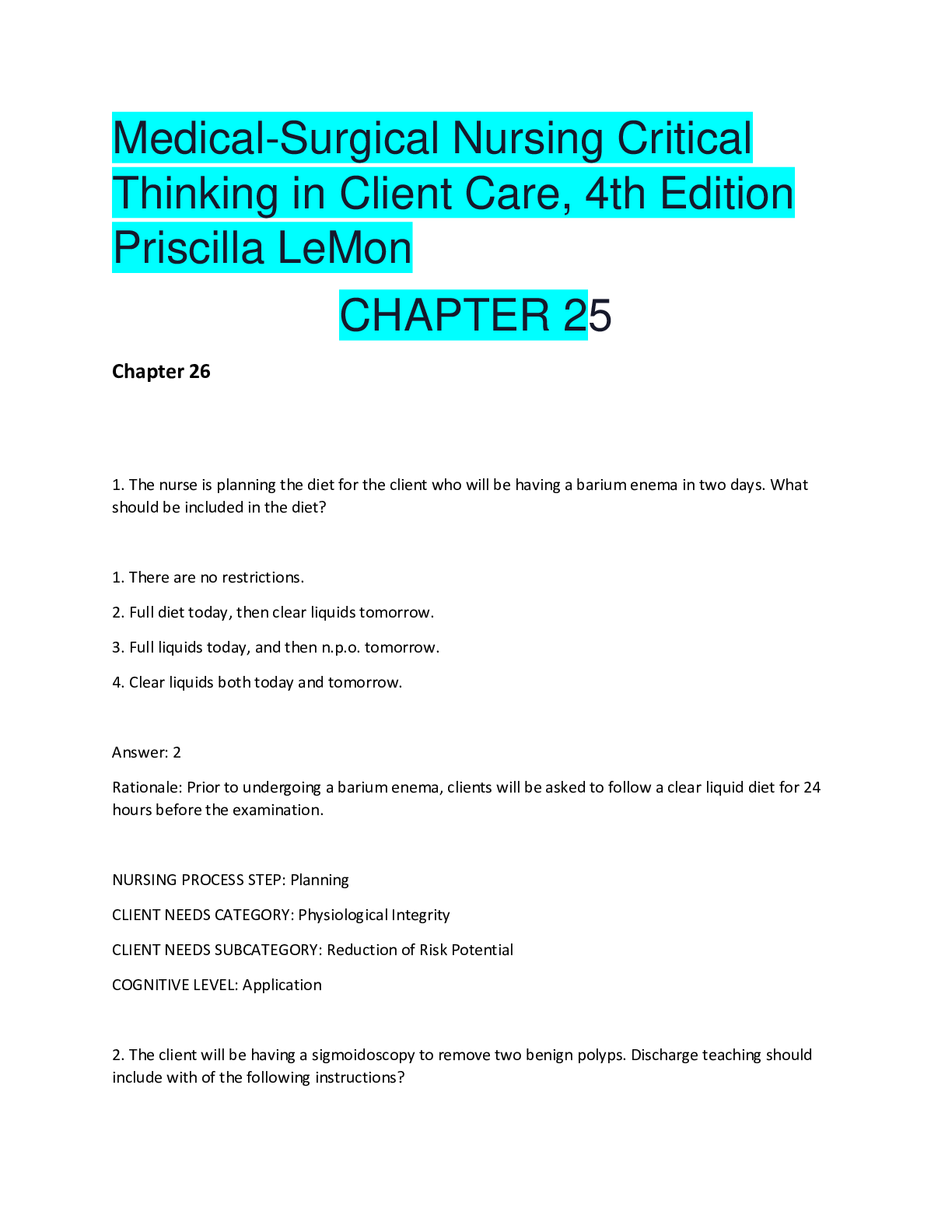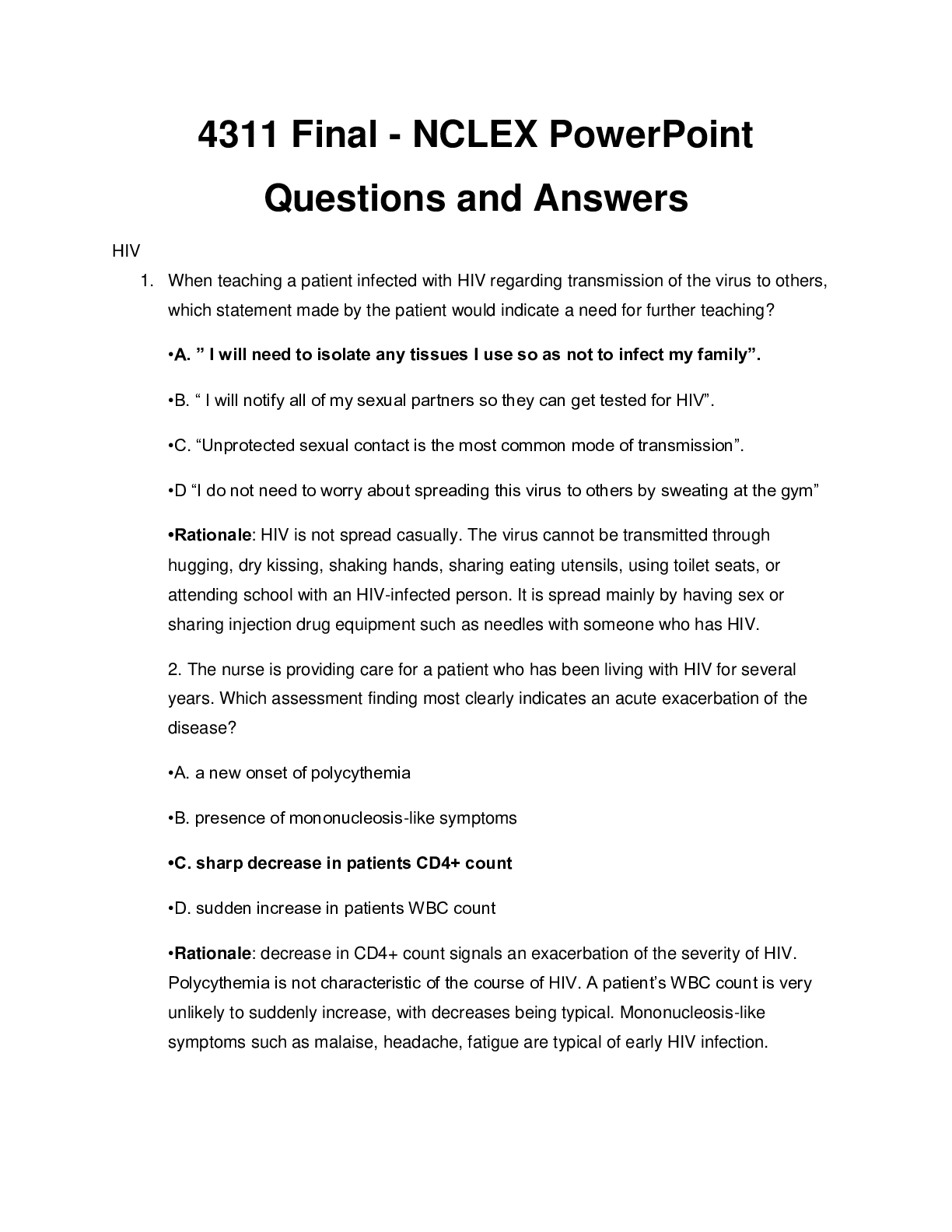*NURSING > QUESTIONS & ANSWERS > NURSE MED SURGE Remediation: CARDIAC DRUGS. Questions & Answers With rationale (All)
NURSE MED SURGE Remediation: CARDIAC DRUGS. Questions & Answers With rationale
Document Content and Description Below
How does angiotensin-converting enzyme (ACE) inhibitors and angiotensin-receptor blockers (ARBs) improve the cardiac function of a client diagnosed with heart failure? - They increase the heart ra... te and decrease the force of the contractions. - They increase the resistance to the (L) ventricular ejection (afterload). - - They promote relaxing of the arterioles and arterial vasodilation. - - They help prevent sodium and water retention by blocking aldosterone. - - They improve the heart's stroke volume, thus improve cardiac output. Client is prescribed angiotensin-converting enzyme (ACE) inhibitors and angiotensin-receptor blockers (ARBs) improve the function of their diagnosed heart failure. What should the nurse assess first prior to administering these medications to a client? Apical pulse. Heart sounds. Blood pressure. Intake and output. . The nurse is caring for a client who has just been placed on lisinopril for treatment of hypertension. The nurse should educate the client about what common side effect of this medication? Frequent urination. Dizziness. Dry skin. Increased hunger. When administering medications, it is important that the nurse understand side effects that may be either drug- or drug class-specific. Dizziness is a common side effect of the class of antihypertensives known as ACE inhibitors. RESPIRATORY DRUGS A nurse riding public transportation notices a child experiencing an asthma attack. The mother of the child pulls out of her purse a medicated discus dispenser of salmeterol xinafoate, a long-acting beta2 agonist, and immediately administers to the child. What is the anticipated outcome of the administration of this medication to this child? Asthmatic symptoms should resolve within 5 to 10 minutes after administration of medication. The child's asthma attack will be unresponsive to the administration of the medication. The medication administration will cause an increased in the child's heart rate. In The bronchioles and alveoli in response to the medication will dilate and lung expansion will increase. A client has been diagnosed with asthma. The nurse should anticipate that the client will need which medication? Oral prednisone. Azithromycin. Albuterol. Solu-medrol. CARDIAC What is the most reliable method a nurse should use to document the status of fluid retention in a client diagnosed with heart failure? Assess their skin turgor. Auscultate their lung sounds. Weigh them daily in the morning. Evaluate them for the presence of edema. Which diet modification is most important for the nurse to include when counseling a client with heart failure? Reduce sodium intake. Increase protein intake. Increase vegetables intake. Reduce carbohydrate intake. Which sign should the nurse expect to observe when caring for a client with right-sided heart failure? Weight loss. Swelling of the feet. Decreased urination. Pink frothy sputum. The nurse is assisting in the evaluation of a client for a possible diagnosis of heart failure. Which assessment tool would not be to diagnose the presence or extent of heart failure? Chest x-ray. Echocardiogram. Electrocardiogram. Radionuclide studies. Question 5 of 5 How does angiotensin-converting enzyme (ACE) inhibitors and angiotensin-receptor blockers (ARBs) improve the cardiac function of a client diagnosed with heart failure? They increase the heart rate and decrease the force of the contractions. They increase the resistance to the (L) ventricular ejection (afterload). They promote relaxing of the arterioles and arterial vasodilation. They help prevent sodium and water retention by blocking aldosterone. They improve the heart's stroke volume, thus improve cardiac output. HEMATOLOGIC The nurse is reviewing client education with a parent and their teenager. Which interventions should help minimize the occurrence of sickle cell crisis? Receive a yearly pneumonia vaccination. Always wear socks and gloves when outside on cold days. Engage in vigorous aerobic exercise at least 3-4 times a week. You should drink at least 3-4 liters of non-caffeinated liquid a day. Avoid cigarettes and/or tobacco products and second hand smoke. The nurse is examining a client for possible anemia. The client complains of fatigue, reduced exercise intolerance, and is pallor in color and has fissures noted at their corners of the mouth. The client's signs and symptoms are indicative of which type of anemia? Aplastic anemia. Iron deficiency anemia. Folic acid deficiency anemia. Vitamin B12 deficiency anemia. What should the nurse identify as a common side effect of ferrous sulfate? Diarrhea. Headache. Vision changes. Dark stools. The nurse is reviewing the bone marrow aspiration results of a client which revealed abnormal high amount of blast cells present. This client will most likely be diagnosed with which condition? Leukemia. Hemophilia. Hodgkin's Lymphoma. Autoimmune thrombocytopenic purpura. The client has been diagnosed with iron deficiency anemia. The nurse should anticipate that the client will need which medication? Hyoscyamine. Ferrous sulfate. Fiber supplements. Lactulose. MUSCULOSKELETAL The nurse case manager is preparing a discharge plan for a client who has had a total hip arthroplasty. What is the most important device the client should have at home as part of the post-op care of the hip prosthesis? Crutches. A raised toilet seat. An assistive ambulatory walker. Grab bars throughout the home. Question 2 of 5 The nurse assessing a client who has been diagnosed with osteoarthritis (OA). Which elements in the client's history are consistent with risk factors for the development of OA? BMI of 23. Vegetarian diet. History of smoking. Construction worker. Previous joint surgery. Question 4 of 5 After assessing a 78-year-old female client, the nurse suspects the client may a hip fracture. Which assessment findings and contributing facts could be associated with of a possible (R) hip fracture? Post-menopausal status. Complaint of (R) groin pain. (R) leg is internally rotated. Leg lengthening of the (R) leg. Limping present with ambulation. Question 5 of 5 A client is having a surgical procedure to relieve their lower back pain caused by a herniated disk. Which surgical procedure if repeated several times may necessitate the client to have a spinal fusion? Allografts. In Diskectomy. Laminectomy. Laser thermodiskectomy. The nurse is assessing a client with a deep puncture wound, accompanied with swelling and erythema noted at the base of frontal (L) knee; the area is hot to touch; and the client complains of constant, throbbing pain which increases with movement. Client's current temperature is 101.6°F (38.7°C) and their leukocytes are double the normal value and the erythrocyte sedimentation rate (ESR) reflects a normal value. The presenting clinical signs and symptoms are indicative of which condition? Osteomyelitis. Ewing's sarcoma. Rheumatoid arthritis. Compartment syndrome. SENSORY A female client has had a scleral buckling with the use of silicone oil for repair of partial retinal detachment of her right eye. The client is transferred to the surgical floor. The client is lying on her left side with her head in the midline position during the nurse's assessment. A protective shield is covering the client's right eye. Which is the most important nursing intervention the nurse should implement post-operatively? In Offer pain medication continuously around the clock. Keep both of the eyes covered with protective eye shields. Ensure the client remains on her left side with her head midline. Administer topical corticosteroids and immunosuppressants. Question 2 of 5 A client who is status post corneal transplant from one week ago, eye's examination revealed slight inflammation in the cornea near the edge of the graft. These assessment findings are indicative of what? In Some inflammation is part of the healing process. Topical corticosteroids should be prescribed for this client. The cornea is showing signs and symptoms of an infectious process. The client will need to be prepped for removal of the transplanted cornea. Question 4 of 5 The nurse observes clouding of the lens when performing an eye examination on a client. The client reports blurry vision, sensitivity to light, and seeing "halos" around lights. Which tool should the nurse anticipate will be used to aid in a diagnosis? Tono-pen. Ophthalmoscope. Refractor. In Snellen chart. A 24 year old male client complains of a continuous low-pitched roar in their ears, occasional dizziness, and uni-lateral hearing loss. Upon inspection of the tympanic membrane, it appears shiny and pearly gray in color. Based on the client's presenting signs and symptoms, the nurse suspects the client will be diagnosed with which condition? Labryinthitis. Acoustic neuroma Meniere's disease. Chronic otitis media. Question 5 of 5 Which medication is used to treat otitis externa? Witch hazel poultice. Oral NSAIDs. Antibiotic drops. Oral antifungals. NEURO Which condition should the nurse identify as a contributing factor for the development of peripheral neuropathy? In Diabetes insipidis. Diabetes mellitus. Congestive heart failure. Hypertension. A client arrives to the emergency department (ED) via ambulance for a suspected stroke. According to the client's spouse, the stroke-like symptoms occurred approximately 1.5 hours ago. An IV of 0.9% Normal Saline is infusing at 75ml/hr. The client has no airway compromise and no arrhythmias have been detected. Admission blood work has been drawn and sent to lab. What should the nurse anticipate as the next action in the client's care? A bilateral carotid ultrasound and endarterectomy. The client transported to radiology for CT scan without contrast. The administration of recombinant tissue plasminogen activator (rtPA). Loading dose of ½ the dose of IV administration of digoxin 8-12 mcg/kg. Question 2 of 5 The nurse is assigned a client who was admitted for a basilar fracture. Which finding is indicative of a complication that should be reported to the healthcare provider immediately? The client's report of some neck stiffness. The presence of new onset of post nasal drip. Client's request for acetaminophen for a headache. Slight increase of temperature to 100.1° F (37.8° C). Question 4 of 5 The nurse is assigned to provide care to a client with traumatic brain injury following a motor vehicle accident. Treatment has included intravenous fluid of hypertonic saline, a mannitol IV bolus, and a hypothermia blanket. The client hs been placed in a barbiturate coma and has been placed on a mechanical ventilator. What is the goal of these medical interventions? Decrease the risk of seizure activity. Prevent increased intracranial pressure. Increase the client's Glasgow Coma Scale score. Promote perfusion and oxygenation to the brain tissue. Question 5 of 5 A client who had brain surgery yesterday is becoming more restless and exhibiting increasing muscle weakness. The client reports extreme thirst and is voiding large amount of diluted urine. Recent laboratory results reflect high serum sodium and high osmolarity. Which condition has the client most likely developed? Diabetes insipidus. Cerebral salt wasting. Increase intracranial pressure. Syndrome of inappropriate antidiuretic hormone. ENDOCRINE DRUGS A client with Graves' disease has been prescribed methimazole. Which explanation by the nurse ly describes how this medication works? It increases absorption of thyroid hormone. It increases availability of thyroid hormone. It helps the body use thyroid hormone more effectively. It interferes with production of thyroid hormone. GASTROINTESTINAL The nurse is monitoring a client who has just returned from a liver biopsy. Which sign should alert the nurse that a serious complication has occurred as a result of this procedure? Confusion. Decreased blood pressure. Nausea and vomiting. In Hematoma at the incision site. Question 5 of 5 A nurse is doing an admission assessment on a client that stated that they have been diagnosed with an ulcer. Which data finding would indicate that they are most likely being treated for a duodenal ulcer? Abdominal pain often awakens them at night. Their physique appears to be undernourished. Eating food appears to relieve the abdominal pain. The abdominal pain happens about 1.5-3 hours after eating. In Location of the pain is more upper gastric towards the (L) midline. The nurse is educating a client with hepatitis. Which medication should the client be advised to avoid? Lisinopril. Metoprolol. Lactulose. Acetaminophen. Question 2 of 5 The nurse is triaging a client with a history of alcoholism who is lying in the fetal position. The client's chief complaint is a sudden, sharp abdominal pain which began in their epigastric and radiates over the entire abdominal area. Their abdomen is tender, rigid and board like; bowel sounds are diminished and their vital signs are T- 102.2° F (39° C); P- 120; RR- 24 and BP- 88/48. Which condition should the nurse suspect the client is experiencing? Peritonitis. Gastric ulcer. Alcohol poisoning. Pyloric obstruction. Question 3 of 5 A client is admitted with coffee ground emesis. This symptom is indicative of which diagnosis? Lower GI bleed. Upper GI bleed. Appendicitis. Diverticulitis. RESPIRATORY The triage nurse is assessing a client with a six week history of a persistent cough producing rusty colored mucus, 10 pounds (4.54kg) weight loss, decreased appetite and night sweats. Based on the client's history which nursing action should the nurse do next? In Request a prescription for chest x-ray and lab work. Place a mask on the client and place the client in a private room. Assess the client's vital signs to include a pulse oximetry reading. Auscultate the lung fields as the client takes deep and slow breaths. Question 3 of 5 A client's assessment findings of hoarseness and audible wheezing noted at 2-3 feet (0.61-0.91 meters); trachea deviation towards the left; breathing pattern with prolonged exhalation followed by periods of shallow breathing; tenderness and increased fremitus with light palpation on the left side of the thorax cavity's base; and an occupation history as an oil refinery plant manager for the past ten years would be indicative of which condition? Flail chest. Emphysema. Lung cancer. In Pneumothorax. Question 5 of 5 A client with a systemic infection has hypoxia despite 100% FiO2 supplementation. The client has pulmonary edema and dyspnea. The nurse notes an increased use of accessory respiratory muscles. The client's chest x-ray indicates dense pulmonary infiltrates with a "ground-glass" appearance. Based on the client's clinical signs and symptoms, which condition is most likely present? In Pulmonary emboli. Legionnaire's disease. Pulmonary hypertension. Acute respiratory distress syndrome. VASCULAR A client who is twelve hours status-post graft for arterial revascularization is complaining of limb pain. Select the appropriate nursing action. In Administer pain medication as prescribed. Immediately notify the surgeon of the finding. Ask the client to describe the pain being experienced. Elevate the extremity and assess the surgical dressing. Question 2 of 5 The nurse is counseling a client about desired goals for their lipids, cholesterol and triglycerides lab levels. Which statement indicates to the nurse the client needs more teaching about targeted lab levels? In The higher my HDL-cholesterol value and the lower my LDL- cholesterol value the better. An elevation in my triglycerides may indicate I have metabolic syndrome. The aim of my treatment is to lower both my HDL-C and the LCL-C serum levels. The total of my serum cholesterol should below 200mg/dL. Question 3 of 5 A client presents with swelling of bilateral lower extremities and darkening of the skin from the feet up into the lower legs. Which disease process should the nurse suspect? Chronic venous insufficiency. Arterial insufficiency. In Deep vein thrombosis. Hypertension. Rationale Chronic venous insufficiency causes pooling of blood and stasis in the lower extremities. This condition is often marked by hyperpigmentation and swelling of the lower legs. Question 4 of 5 The client's lower extremity has an ulcer present. Which findings would indicate to the nurse that the ulcer is a venous ulcer? The ulcer is located in the ankle area. In The lower extremities pulses are decreased. The area with the ulcer is located is edematous. The ulcer bed is pink with granulation tissue present. Dependent rubor is present in the extremity with the ulcer. Question 5 of 5 An ambulatory client has developed an ulcer as a result from chronic venous insufficiency that is non-healing and causing edema in the lower leg. The nurse should anticipate the healthcare provider's plan of care to include? Arterial revascularization. In Cauterization of the wound bed. Surgical transplant of venous valves. Unna boot that has been moistened with zinc oxide. ENDOCRINE To help prevent the development of nutrition-induced hypothyroidism which types of foods should the nurse advise a client to consume? Beans and legumes. Steak and roast beef. In Fresh and frozen fruit. Seafood such as lobster and shrimp In Freshwater fish such as bass and trout. A nurse is assessing a client who is 24 hours post-op hypophysectomy (removal of the pituitary gland). The client complains to the nurse of postnasal drip that is bothering them and causing them excessive swallowing. The client's complaint may be indicative of what? An allergic reaction. Possible CSF leakage. Sign of nerve damage. An expected post-op finding. Question 3 of 5 A nurse is assessing a client being ruled out for hypopituitarism as a result of a tumor. Which neurological symptom would occur first in this condition of hypopituitarism? A change in the sense of smell. Ringing and static noise in the ears. Changes in the vision, particularly peripheral. The sense of taste is diminished, especially salty. Question 4 of 5 The client diagnosed with thyroid nodules asks the nurse how the healthcare provider will determine if surgery is needed to treat their thyroid condition. Which procedure is used to determine if surgical intervention is indicated? CT scans. Ultrasound. Needle biopsy. MRI with contrast. Rationale A needle biopsy is done to determine the composition of the thyroid nodules. Based on what the biopsy reveals, will determine if surgical removal of the nodules is necessary Question 5 of 5 A client with Graves' disease has been prescribed methimazole. Which explanation by the nurse ly describes how this medication works? It increases absorption of thyroid hormone. It increases availability of thyroid hormone. It helps the body use thyroid hormone more effectively. It interferes with production of thyroid hormone. MULTI SYSTEM A client wanders into the emergency department confused and somnolent. The client is bleeding profusely from the first three digit sites which have been severed from the hand from a lawn mower accident. The nurse immediately applies pressure to the severed sites. Which nursing action should the nurse do next? Start an IV with two large bore needles and place supine on the gurney. Placed the client on a gurney with their feet elevated and their head flat and apply oxygen. In Apply a tourniquet and ice to the site and have client sit upright with arm above heart level. Placed the client in a fowler's position with their arm elevated above their head and apply oxygen. Question 2 of 5 A nurse is assigned a client who was being treated for early sepsis with IV antibiotics and IV fluids. During the client's assessment the nurse notes that the client's blood pressure which was 86/52mmHg is now 118/78mmHg; their skin which was cool is now appears pink and warm to touch and their heart rate has increased from 75-89 beats per minute. How should the nurse interpret these assessment findings? Select the most appropriate statement. In The client appears to be responding well to the antibiotic therapy. The status of the client is improving as evident by the skin changes. The condition of the client may be getting worse rather than improving. The circulation is improving as evidenced of the increased blood pressure and skin. Question 3 of 5 A nurse is assigned the care of a client who is presently experiencing hypovolemic shock. The client's MAP has decreased by 20 mmHg from its baseline, tissue ischemia and anoxia of non-vital organs is occurring, pulses are weak, urine output is absent and the client's skin is cool and moist. The client appears to be confused and extremely anxious. Which stage of hypovolemic shock do these clinical signs and symptoms indicate? Initial stage. In Refractory Stage. Progressive stage. Non-progressive stage. A client who is status post thyroidectomy 12 hours ago appears to be becoming increasingly anxious and is complaining about being uncomfortable and extremely thirsty. 1The nurse notes the client is lying in bed supine with the head of the bed elevated 30°; their neck dressing appears to be dry and intact; and NS @60ml/hr is infusing without any signs and/or symptoms of infiltration. Which intervention should the nurse implement first? Offer the client their prescribed pain medication. Obtain a prescription to obtain a serum calcium level. Reassure the client and state to them it appears you are anxious. Gently roll the client to the side and inspect the back of their neck area. Question 5 of 5 Which treatment should the nurse plan to implement for a client diagnosed with septicemia? PO antibiotics and IV fluid resuscitation. IV antibiotics and IV fluids at a keep open rate. IV antibiotics and IV fluid resuscitation. PO antibiotics and IV fluids at a keep open rate. RENAL A client diagnosed with kidney stones is experiencing a urine output decrease of less than 0.5ml/kg per hour; increase BUN and creatinine levels; decrease glomerular filtration rate; flank pain and wheezes and crackles in their lungs, along with 2+ pitting edema in their extremities. Which complication is the client most likely developing? Cystitis. Urolithiasis. In Pyelonephritis. Acute kidney injury. When formulating a nutrition plan for a client diagnosed with renal failure, which food should the nurse recommend that the client avoid? Bananas. Green beans. Carrots. Cucumbers. Question 3 of 5 Which condition is a leading cause of renal failure? Hypertension. Crohn's disease. Iron deficiency anemia. Chronic obstructive pulmonary disease. Question 4 of 5 Which non-surgical procedure would a nurse anticipate a healthcare provider to prescribe to aid in the removal of the kidney stones if a client has been unresponsive to thiazide medication? Lithotripsy. Ureteroscopy. Pyelolithotomy. Percutaneous nephrolithotomy. Question 5 of 5 A client with a chief complaint of severe, spasmodic pain in their (R) flank area that comes and goes accompanied with nausea and diaphoresis has additional assessment findings of hematuria and cloudiness appearance of their urine and a history of gout. The client denies any fevers or chills and is presently ad febrile.Based on these findings which condition would the nurse suspect? Urolithiasis. Urothelial cancer. Urinary incontinence. Urinary tract infection. [Show More]
Last updated: 2 years ago
Preview 1 out of 31 pages
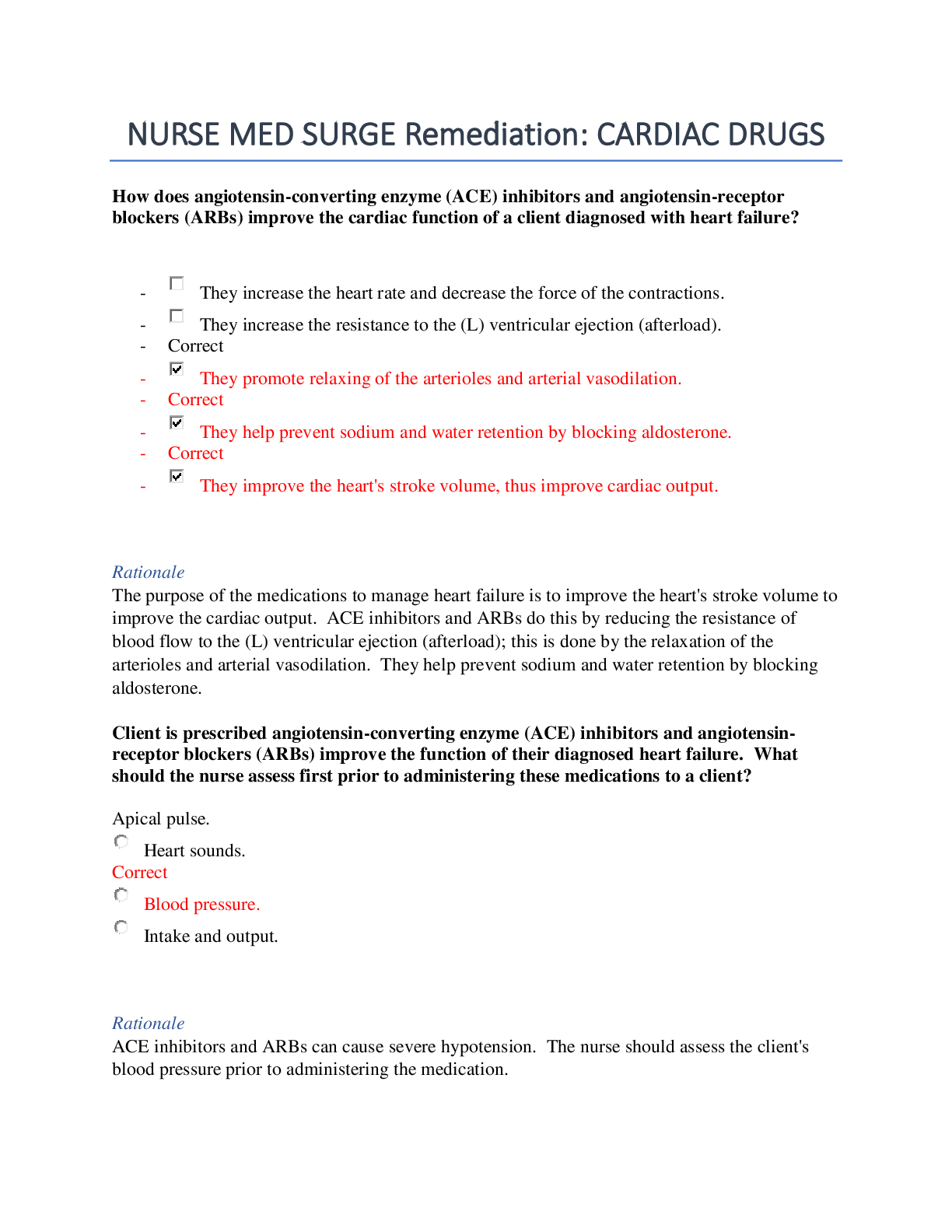
Buy this document to get the full access instantly
Instant Download Access after purchase
Buy NowInstant download
We Accept:

Reviews( 0 )
$10.00
Can't find what you want? Try our AI powered Search
Document information
Connected school, study & course
About the document
Uploaded On
Jun 24, 2020
Number of pages
31
Written in
Additional information
This document has been written for:
Uploaded
Jun 24, 2020
Downloads
0
Views
139


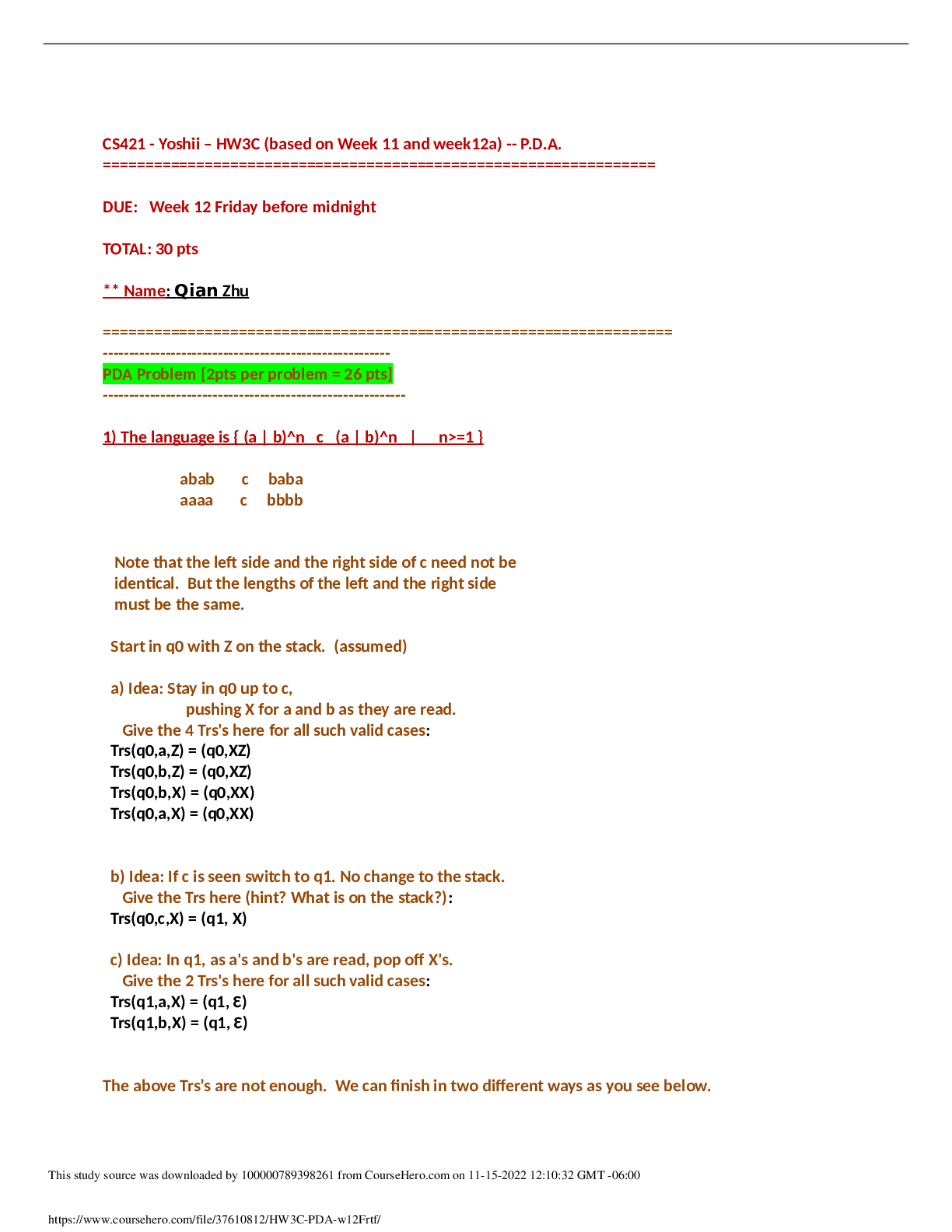


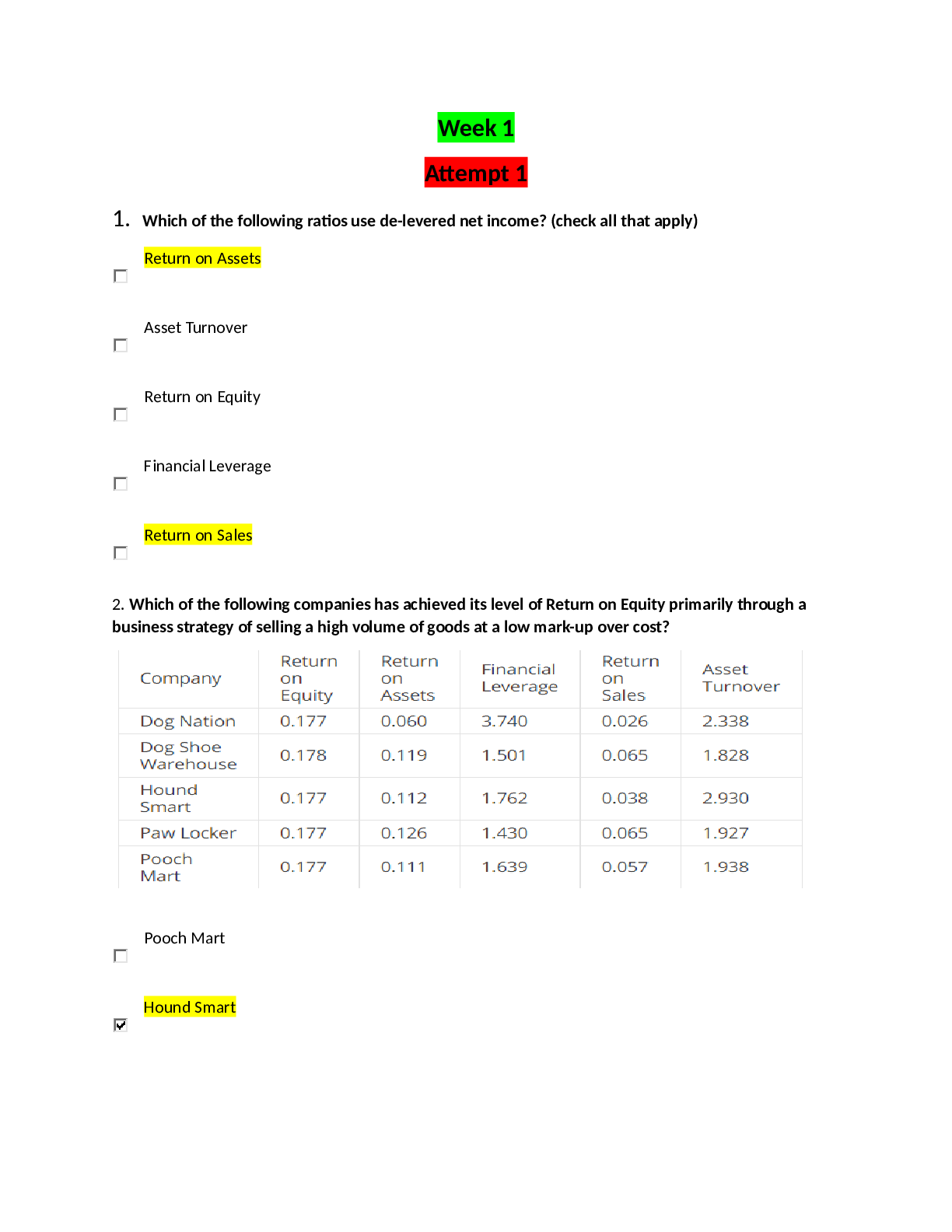
.png)
.png)
.png)
.png)
.png)
.png)
.png)




